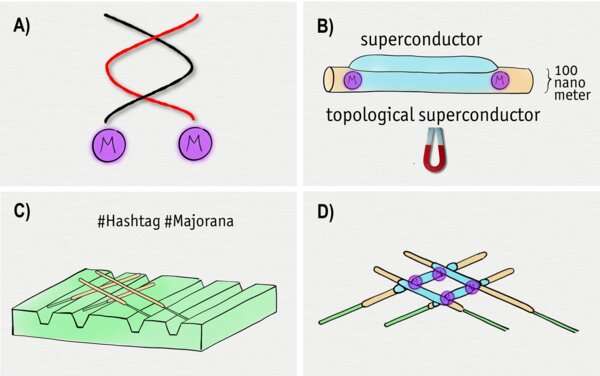28 years old and closer than ever to the solving of the mystery of the Majorana particles

Gazibegović, Ph.D. candidate in the group of prof. Erik Bakkers at the department of Applied Physics, developed a device made of ultrathin networks of nanowires in the shape of "hashtags." This device allows pairs of Majorana particles to exchange position and keep track of the changes occurred, in a phenomenon known as "braiding." This event is considered as a striking proof of the existence of Majorana particles, and it represents a crucial step towards their use as building blocks for the development of quantum computers. With two Nature publications in her pocket, Gazibegović is ready to defend her Ph.D. thesis on May 10.
In 1937, the Italian theoretical physicist Ettore Majorana hypothesized the existence of a unique particle that is its own antiparticle. This particle, also referred to as a "Majorana fermion," can also exist as a "quasiparticle," a collective phenomenon that behaves like an individual particle, as in waves forming on the water. The water itself stays in the same place, but the wave can "travel" on the surface, as if it were a single particle in movement. For many years, physicists have been trying to find the Majorana particle without success. Yet, in the last decade, scientists from Eindhoven University of Technology have taken great leap forwards in proving the existence of Majorana particles, also thanks to the research of Gazibegović and her collaborations with the University of Delft, Philips Research and the University of California – Santa Barbara.
Building blocks of quantum computers
Majorana particles have for long represented the "holy grail" for particle physicists, also for their potential use as quantum bits, or "qubits," the basic building blocks of quantum computers. Instead of the 1 or 0-bits of regular computers, qubits can be 1 and 0 at the same time. Collections of qubits can be used to do several calculations at the same time, which makes quantum computers, on paper, much faster than regular computers.
In reality, to date, the making of properly functioning qubits has remained devilishly difficult. Before the proof of the existence of Majorana particles, researchers used other particles at the atomic scale as qubits. Yet, these particles turned out to be sensitive and fragile, and, as a result, the quantum information tended to fade away within fractions of seconds. In this respect, Majorana particles still represent the promising building block due to one specific property: their inherent stability.
Braiding, thus stability
The stability of Majorana particles can be attributed to a special phenomenon called "braiding." When two Majorana particles exchange position twice—from a starting configuration to a new one, and then back to the starting one—the two particles will entangle and gain stability, similarly to two loose ends of a strip that, when exchanged twice, are braided (FIG.1A).
Hashtags
To generate Majorana particles, Gazibegović first developed the so-called topological superconductors, nanowires made from indium phosphide (InP) with a layer of a superconductor on top (Fig.1B).
When a magnetic field is applied to the topological superconductor, Majorana particles emerge at the extremities of the device. Series of topological superconductors were then grown from a specially etched substrate (Fig.1C, Fig.2) in the shape of hashtags (Fig.1D, Fig.2), so that each hashtag would be able to produce four Majorana particles, one near each intersection point.

Smoother interfaces, better quality
"One of the unmet challenges in this field," explains Gazibegović, "is to improve the quality of the interface between the semiconductor and the superconductor. Roughness introduced at this interface may indeed destroy the properties of the Majorana state." To solve this issue, Gazibegović and her colleagues fabricated the topological superconductors under ultra-high vacuum, which protected them from exposure to chemical etchants and allowed the fabrication of devices with "unprecedented quality."
All over the world
The building these devices turned out to be a real life experience for Gazibegović, during and outside working hours. In the last few years, Gazibegović has clocked up the miles and crossed the ocean several times, together with her nano-hashtags.
"The substrates were fabricated in Delft," she explains, "and they had to be then transferred in Eindhoven for the following step, the growing of the nano-hashtags. Once ready, they would then be assembled into topological superconductors in Santa Barbara, in California."
Computing power
Gazibegović: "This thesis contains new insights on the growth mechanisms of nanowires, as well as design principles to create complex geometries." These breakthroughs in materials science have already resulted in improved Majorana device quality, and offer unprecedented opportunities for quantum technology and its applications.
"Researchers," continues Gazibegović, "spent decades comparing the effects of different drugs on a number of diseases. This process might be significantly shortened with quantum computers that have enough computational power to envision, in one go, all the possible outcomes."
Journal information: Nature
Provided by Eindhoven University of Technology





















